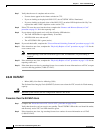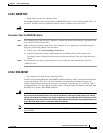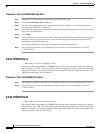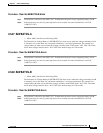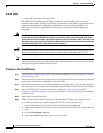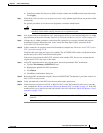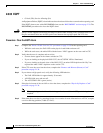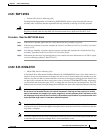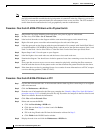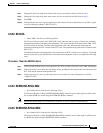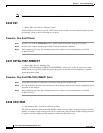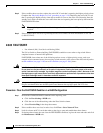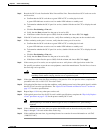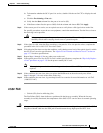
2-52
Cisco ONS 15327 Troubleshooting Guide, R3.4
March 2004
Chapter 2 Alarm Troubleshooting
Alarm Procedures
Note The physical switch procedure is the recommend method of clearing the E-W-MISMATCH alarm. The
physical switch method reestablishes the logical pattern of connection in the ring. However, you can also
use CTC to recreate the span and identify the misconnected slots as east and west. The CTC method is
useful when the misconnected node is not geographically near the troubleshooter.
Procedure: Clear the E-W-MISMATCH Alarm with a Physical Switch
Step 1 Diagram the ring setup, including nodes and spans, on a piece of paper or white board.
Step 2 In node view, click View > Go to Network View.
Step 3 Label each of the nodes on the diagram with the same name that appears on the network map.
Step 4 Right-click each span to reveal the node name/slot/port for each end of the span.
Step 5 Label the span ends on the diagram with the same information. For example, with Node1/Slot12/Port1
to Node2/Slot6/Port1 (2F BLSR OC48, Ring ID=0), label the end of the span that connects Node 1 and
Node 2 at the Node 1 end as Slot 12/Port 1. Label the Node 2 end of that same span Slot 6/ Port 1.
Step 6 Repeat Steps 4 and 5 for each span on your diagram.
Step 7 Label the highest slot at each node east and the lowest slot at each node west.
Step 8 Examine the diagram. You should see a clockwise pattern of west slots connecting to east slots for each
span.
Step 9 If any span has an east-to-east or west-to-west connection, physically switching the fiber connectors
from the card that does not fit the pattern to the card that continues the pattern should clear the alarm.
Step 10 If the alarm does not clear, log onto http://www.cisco.com/tac for more information or call TAC to report
a service-affecting problem (1-800-553-2447).
Procedure: Clear the E-W-MISMATCH Alarm in CTC
Step 1 Log into the misconnected node. A misconnected node has both ring fibers connecting it to its neighbor
nodes misconnected.
Step 2 Click the Maintenance > BLSR tabs.
Step 3 From the row of information for the fiber span, complete the “Identify a Ring ID or Node ID Number”
procedure on page 2-125 to identify the node ID, ring ID, and the slot and port in the East Line list and
West Line columns. Record the information.
Step 4 Click View > Go to Network View.
Step 5 Delete and recreate the BLSR:
a. Click the Provisioning > BLSR tabs.
b. Click the row from Step 3 to select it and click Delete.
c. Click Create.
d. Fill in the ring ID and node ID from the information collected in Step 3.
e. Click Finish in the BLSR Creation window.
Step 6 Display the node view and click the Maintenance > BLSR tabs.



